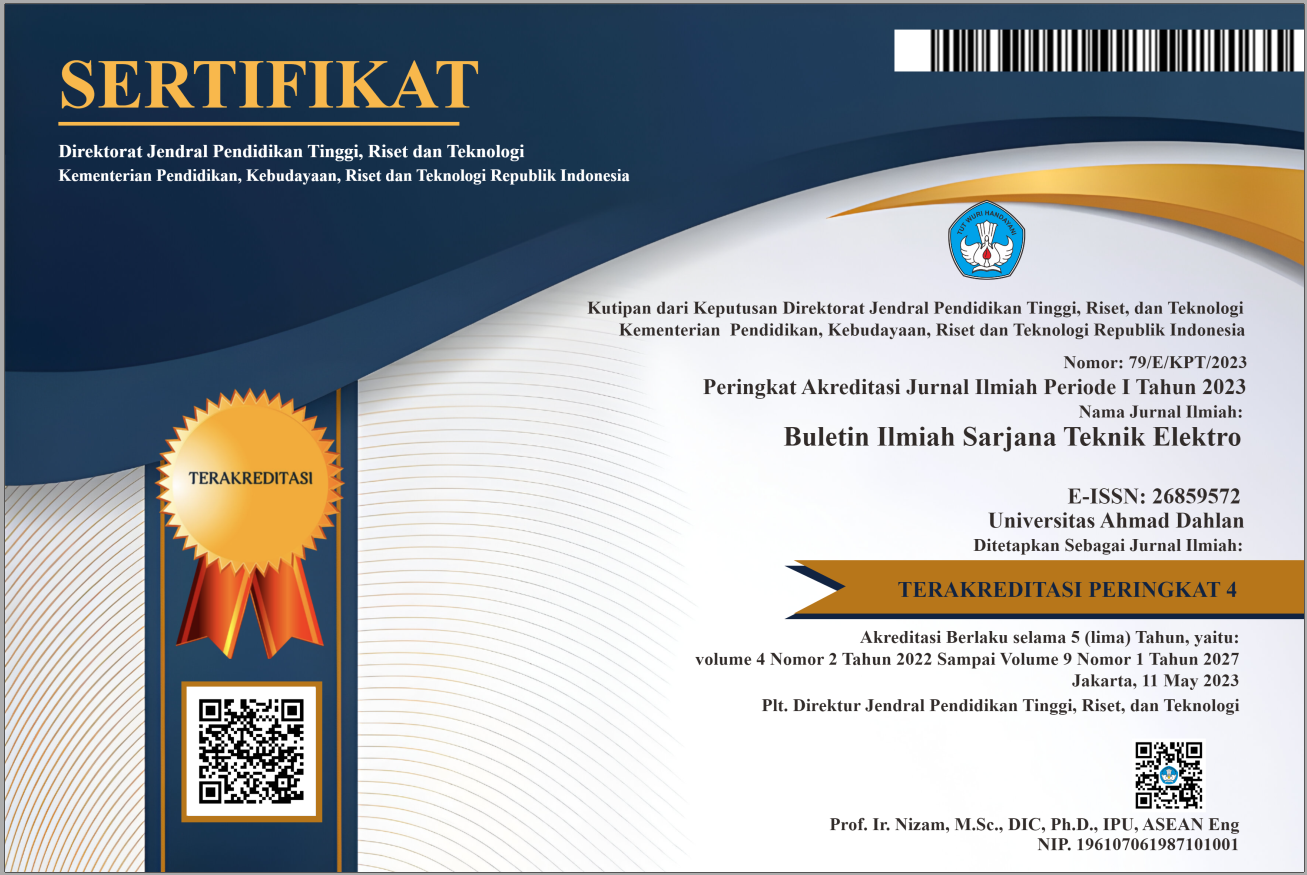Techno – Economic Analysis of Rooftop Solar Panel Uprating on Commercial Building (Casestudy on Karawang Branch Office of XYZ Company)
DOI:
https://doi.org/10.12928/biste.v5i1.7579Keywords:
Solar Rooftop, Techno-Economic Analysis, PV Capacity, Solar Module, Payback PeriodAbstract
On April 22nd, 2016, Indonesia signed the Paris Agreement, which goal is that the world will enter the net-zero emission phase in 2060. To support that, it is better to increase the solar rooftop capacity have been installed. In this study, there are some variations, such as the capacity of solar rooftops based on load profile and installed power (75%, 90%, and 100%), variation of solar module placement, and variation of solar module types. The result shows that to fulfill the load needs, it will need 40 kW of inverter capacity and 49.5 kWp of PV capacity with a total module of 113 pcs. Based on the solar module type simulations result, the 440 Wp B – brand has the highest performance result among the others. Uprating solar rooftop capacity will cost around Rp.1,138,529,870 for the investment, and the payback period is around 18 years. This study finds that uprating the capacity of rooftop solar panel can reduce electricity tariffs and increase energy production. Moreover, the results of the economic analysis revealed that the initial cost, interest rate, and electricity price will play crucial roles in determining whether to launch a project or not.
References
Global Energy Statistical, “Total energy consumption”, Enerdata, 2022, https://yearbook.enerdata.net/total-energy/world-consumption-statistics.html.
Directorate of Sustainability, Technology and Outlooks, “World Energy Outlook 2022”, International Energy Agency, Paris, 2022, https://www.iea.org/reports/world-energy-outlook-2022.
IRENA, “Indonesia energy transition outlook”, International Renewable Energy Agency, Abu Dhabi, 2022, https://www.irena.org/publications/2022/Oct/Indonesia-Energy-Transition-Outlook.
Siaran Pers Kementerian LHK, “Indonesia Signs Paris Agreement on Climate Change”, Jakarta 2016, http://ppid.menlhk.go.id/siaran_pers/browse/299.
United Nations Climate Change Secretariat, “Climate Action Now, Summary for Policymakers”, Bonn, 2016, https://unfccc.int/resource/climateaction2020/media/1309/Summary_for_policymakers.pdf.
Department of Economic and Social Affairs, United Nation, “Conference Summary: Maximizing Co-Benefts by Linking Implementation of the Sustainable Development Goals and Climate Action”, Global Conference on Strengthening Synergies between The Paris Agreement on Climate Change and the 2030 Agenda for Sustainable Development, Copenhagen, 2019, https://sdghelpdesk.unescap.org/e-library/maximizing-co-benefits-linking-implementation-sustainable-development-goals-and-climate.
Kementerian ESDM, “Rencana Usaha Penyediaan Tenaga Listrik PT. PLN (Persero), tahun 2021 – 2030”, Jakarta, 2021, https://web.pln.co.id/statics/uploads/2021/10/ruptl-2021-2030.pdf.
IESR, “Indonesia Energy Transition Outlook 2021”, Jakarta, 2021, https://iesr.or.id/en/pustaka/indonesia-energy-transition-outlook-ieto-2021.
Presidential Regulation of The Republic of Indonesia Number 98 of 2021, 2021, https://jdih.maritim.go.id/cfind/source/files/perpres/2021/perpres-nomor-98-tahun-2021-english-version.pdf.
B. D. Siregar, B. Sudiarto and R. Setiabudy, “Economic Analysis of Renewable Energy Power Plant in Sumatra, Indonesia,” 2019 IEEE International Conference on Innovative Research and Development (ICIRD), pp. 1-4, 2019, https://doi.org/10.1109/ICIRD47319.2019.9074768.
R. Alawneh, F. E. M. Ghazali, H. Ali and M. Asif, “Assessing the contribution of water and energy efficiency in green buildings to achieve United Nations Sustainable Development Goals,” Building and Environment, vol. 146, pp. 119-132, 2018, https://doi.org/10.1016/j.buildenv.2018.09.043.
A. M. Ismail, R. R-. Iniguez, M. Asif, A. B. Munir, F. M-. Sukki, “Progress of solar photovoltaic in ASEAN countries: A review,” Renewable and Sustainable Energy Reviews, vol. 48, pp. 399-412, 2015, https://doi.org/10.1016/j.rser.2015.04.010.
A. M. Bagher, M. M. A. Vahid and M. Mohsen, “Types of solar cells and application,” American Journal of Optics and Photonics, vol. 3, pp. 94-113, 2015, https://doi.org/10.11648/j.ajop.20150305.17.
G. B-. Weiss, C. Wray, W. Delp, P. Ly, H. Akbari and R. Levinson, “Electricity production and cooling energy savings from installation of a building integrated photovoltaic roof on an office building,” Energy and Buildings, vol.56, pp. 210-220, 2013, https://doi.org/10.1016/j.enbuild.2012.06.032.
W. Zhang, L. Lu and J. Peng, “Evaluation of potential benefits of solar photovoltaic shadings in Hong Kong”, Energy, vol. 137, pp. 1152-1158, 2017, https://doi.org/10.1016/j.energy.2017.04.166.
A. F. Madsuha, E. A. Setiawan, N. Wibowo, M. Habiburrahman, R. Nurcahyo and S. Sumaedi, “Mapping 30 Years of Sustainability of Solar Energy Research in Developing Countries: Indonesia Case,” Sustainability, vol. 13, no. 20, p. 11415, 2021, https://doi.org/10.3390/su132011415.
M. D. E. Hakim et al., “Optimum Location for PV Implementation Based on Load-flow Analysis Using Newton-Raphson Method for Lombok Electrical Network,” 2019 IEEE International Conference on Innovative Research and Development (ICIRD), pp. 1-5, 2019, https://doi.org/10.1109/ICIRD47319.2019.9074728.
F. Husnayain and D. Luthfy, “Analisis rancang bangun PLTS ON-Grid hibrid baterai dengan PVSYST pada kantin teknik FTUI,” ELECTRICES, vol. 2, no. 1, pp. 21–29, 2020, https://doi.org/10.32722/ees.v2i1.2846.
F. Miftahurrahman, Farizal and M. Dachyar, “Optimization Model of Power Generation and Load Equipment Selection for near Zero Energy Building with Rooftop PV Integrated,” 2019 IEEE 6th International Conference on Engineering Technologies and Applied Sciences (ICETAS), pp. 1-5, 2019, https://doi.org/10.1109/ICETAS48360.2019.9117344.
M. M. Ibrahim, M. A. Badr and A. E. Berry, “Feasibility and Performance Analysis of Grid-Tied Solar Photovoltaic Systems Using PVsyst Simulation Package of Pharmaceutical Factory Case Study in Egypt,” International Journal of Energy, Environment and Economics, vol. 26, no. 4, pp. 249-267, 2018, https://www.proquest.com/docview/2466372359?pq-origsite=gscholar&fromopenview=true.
N. Mukisa, R. Zamora and T. T. Lie, "Feasibility Assessment of Grid-Tied Rooftop Solar Photovoltaic Systems for Industrial Sector Application in Uganda", Sustainable Energy Technologies and Assessments, vol. 32, pp 83-91, 2019, https://doi.org/10.1016/j.seta.2019.02.001.
K. Shi, C. Li and C. Koo, “A Techno-Economic Feasibility Analysis of Mono-Si and Poly-Si Photovoltaic Systems in the Rooftop Area of Commercial Building under the Feed-In Tariff Scheme,” Sustainability, vol. 13, no. 9, p. 4709, 2021, https://doi.org/10.3390/su13094709.
Yousef Gharbia, and Mohammed Anany, "Techno-Economic Feasibility Study of Installing Solar PV Systems on Gas Stations' Rooftops in Kuwait", ASME International Mechanical Engineering Congress and Exposition, vol.6, 2018, https://doi.org/10.1115/IMECE2017-70156.
Kementerian ESDM, “Permen ESDM No. 26 Tahun 2021 tentang PLTS Atap,” 2021, https://drive.esdm.go.id/wl/?id=5XQv80ogkSp0tLQsY4wJNUPVSPpcgGtz.
A. Afandi, M. D. Birowosuto and K. C. Sembiring, “Energy-yield Assessment Based on the Orientations and the Inclinations of the Solar Photovoltaic Rooftop Mounted in Jakarta, Indonesia,” International Journal on Advanced Science, Engineering and Information Technology, vol. 12, no. 2, pp. 470-476, 2022, http://dx.doi.org/10.18517/ijaseit.12.2.14812.
H. Gunawan and B. Sudiarto, “Simulasi Perbandingan Perubahan Tilt Terhadap Energi Array pada 34 Unit PLTS Rooftop 100 Kwp di Indonesia,” Citizen: Jurnal Ilmiah Multidisiplin Indonesia, vol. 2, no. 1, pp. 46-55, 2022, https://doi.org/10.53866/jimi.v2i1.27.
T.V. Christiaanse, R.C.G.M. Loonen and R. Evins, “Techno-economic optimization for grid-friendly rooftop PV systems – A case study of commercial buildings in British Columbia,” Sustainable Energy Technologies and Assessments, vol. 47, 2021, https://doi.org/10.1016/j.seta.2021.101320.
K. Mongkoldhumrongkul, “Techno-economic analysis of photovoltaic rooftop system on car parking area in Rayong, Thailand”, Energy Reports, vol. 9, pp. 202-212, 2023, https://doi.org/10.1016/j.egyr.2022.10.421.
O. V. Nugroho, N. F. Pramono, M. P. Hanafi, F. Husnayain and A. R. Utomo, “Techno-economic analysis of hybrid Diesel-PV-Battery system and hybrid Diesel-PV-Wind-Battery system in Eastern Indonesia,” IOP Conference Series: Earth and Environmental Science (EES), vol. 599, 2020, https://doi.org/10.1088/1755-1315/599/1/012031.

Published
How to Cite
Issue
Section
License
Copyright (c) 2023 Aji Nur Widyanto, Muhamad Arya Krisna Adhi, Faiz Husnayain, Agus R Utomo, I Made Ardita

This work is licensed under a Creative Commons Attribution-ShareAlike 4.0 International License.
Authors who publish with this journal agree to the following terms:
- Authors retain copyright and grant the journal right of first publication with the work simultaneously licensed under a Creative Commons Attribution License that allows others to share the work with an acknowledgment of the work's authorship and initial publication in this journal.
- Authors are able to enter into separate, additional contractual arrangements for the non-exclusive distribution of the journal's published version of the work (e.g., post it to an institutional repository or publish it in a book), with an acknowledgment of its initial publication in this journal.
- Authors are permitted and encouraged to post their work online (e.g., in institutional repositories or on their website) prior to and during the submission process, as it can lead to productive exchanges, as well as earlier and greater citation of published work (See The Effect of Open Access).
This journal is licensed under a Creative Commons Attribution-ShareAlike 4.0 International License.


